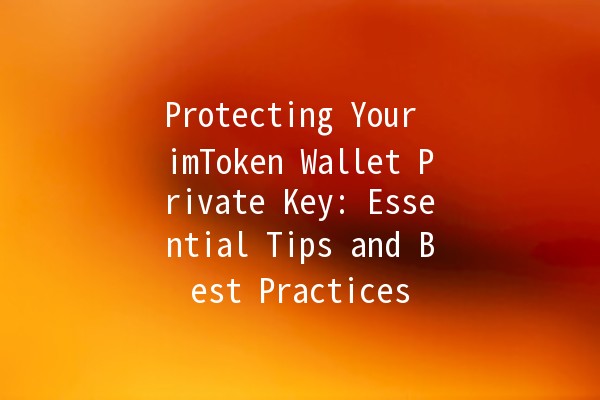In the digital age, securing your cryptocurrency assets is paramount. Among various types of cryptocurrency wallets, imToken has gained popularity for its userfriendly interface and robust security features. However, the safety of your assets largely hinges on how well you protect your private key. This article explores crucial ways to safeguard your imToken wallet's private key, ensuring your digital assets remain secure from unauthorized access.
Before diving into the protection methods, it's crucial to grasp why the private key is vital. The private key acts as the password to your cryptocurrency wallet. It allows you to access and manage your assets. If someone gains access to your private key, they can steal your cryptocurrency effortlessly. Therefore, protecting this key is not just a recommendation but a necessity.
A private key is an alphanumeric string of characters generated when you create a cryptocurrency wallet. In the case of imToken, it secures your wallet, allowing you to sign transactions. If you lose your private key or if it falls into the wrong hands, you lose access to your funds forever.

Description:
Enabling 2FA adds an additional layer of security to your imToken wallet. Even if someone gets hold of your password, they would need the second factor, usually a temporary code sent to your phone, to gain access.
Practical Application:
Set up 2FA by linking your imToken wallet to a mobile authentication app like Google Authenticator or Authy. This way, after entering your password, you'll need to input a code generated by the app. Always keep the app updated and backed up. If you change phones, remember to transfer your 2FA settings.
Description:
Hardware wallets are physical devices that securely store your private keys offline. This makes them considerably less vulnerable to online threats.
Practical Application:
For longterm storage of your cryptocurrency, invest in a reputable hardware wallet such as Ledger Nano S or Trezor. Before transferring your assets, ensure that the wallet supports imToken and follow the manufacturer's instructions for setting it up. Always remember to keep your hardware wallet in a safe place.
Description:
Regularly backing up your wallet ensures you can recover it in case of device failure or loss. Secure storage of these backups is equally important.
Practical Application:
Create a backup of your imToken wallet by exporting your private key to a secure file format. Store this backup in multiple secure locations, such as a USB drive, an encrypted cloud service, or even printed on paper and stored in a safe. Ensure that your backups are updated in case of any changes to your wallet.
Description:
Phishing scams are a prevalent threat in the cryptocurrency space, where attackers impersonate legitimate services to steal sensitive information.
Practical Application:
Always verify the authenticity of websites and emails before entering any information. Doublecheck the URL of any imTokenrelated site to ensure it’s legitimate. Avoid clicking on links from untrusted sources. Using a password manager can help by storing and autofilling passwords only on verified sites.
Description:
Keeping your imToken wallet and the software it depends on is crucial for protection against vulnerabilities.
Practical Application:
Regularly check for updates to the imToken app and your device’s operating system. Developers often release updates to patch security vulnerabilities. Enable automatic updates if possible to ensure you're always protected with the latest security measures.
Losing access to your private key means you cannot access your cryptocurrency. It’s essential to have multiple secure backups. If you’ve followed the steps mentioned above and have backups, you can restore your wallet. If not, unfortunately, there's no way to recover access, highlighting the importance of securing your private key in the first place.
Unfortunately, there are no ways to recover a lost private key if you haven't created a backup. However, if you’ve backed up your recovery phrase or exported your private key during setup, you can restore access to your imToken wallet with those. Make it a habit to regularly check that your backups are intact and accessible.
Hardware wallets store your private keys offline, making them less susceptible to hacking and online attacks. While online wallets, such as imToken, are convenient for daily transactions, hardware wallets are designed for secure longterm storage, greatly minimizing potential risks.
To enable 2FA on your imToken wallet, go to the security settings of the app. You will need to link your wallet with an authentication app like Google Authenticator. Follow the instructions in the app to generate and input the 2FA code whenever you log in. This adds an extra layer of security, ensuring that your account is safer.
Signs of a compromised wallet include unauthorized transactions, emails from imToken about logins or changes you did not initiate, or being unable to log into your account. If you suspect any issues, immediately change your passwords, and enable 2FA if not already set. Additionally, transfer your assets to a new, secure wallet.
Saving your private key in a digital note is not advisable due to potential exposure. Instead, use encrypted file storage or choose a secure physical space for a printed copy. Always prioritize offline and secure methods for storing sensitive information such as private keys.
Protecting your imToken wallet’s private key is vital for ensuring the security of your cryptocurrency investments. By implementing robust security measures such as enabling twofactor authentication, using hardware wallets, regularly backing up your wallet, avoiding phishing scams, and keeping your software updated, you can significantly reduce the risk of unauthorized access. Stay vigilant, practice good security hygiene, and you can enjoy the benefits of your digital assets safely.